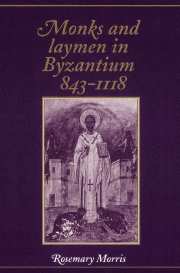Book contents
- Frontmatter
- Contents
- List of maps
- List of tables
- Acknowledgements
- Note on transliteration and citation
- List of abbreviations
- Introduction
- PART I FOUNDERS AND BENEFACTORS
- 1 The resurgence of the monastic life
- 2 Groups, communities and solitaries
- 3 Monastic founders
- 4 Monasticism and society
- 5 Piety, patronage and politics
- PART II PROTECTION AND SURVIVAL
- Appendix: Imperial privileges to monasteries, c. 900–1118
- Bibliography
- Index
2 - Groups, communities and solitaries
from PART I - FOUNDERS AND BENEFACTORS
Published online by Cambridge University Press: 10 December 2009
- Frontmatter
- Contents
- List of maps
- List of tables
- Acknowledgements
- Note on transliteration and citation
- List of abbreviations
- Introduction
- PART I FOUNDERS AND BENEFACTORS
- 1 The resurgence of the monastic life
- 2 Groups, communities and solitaries
- 3 Monastic founders
- 4 Monasticism and society
- 5 Piety, patronage and politics
- PART II PROTECTION AND SURVIVAL
- Appendix: Imperial privileges to monasteries, c. 900–1118
- Bibliography
- Index
Summary
The two centuries following the triumph of orthodoxy saw a remarkable revival in the fortunes of Byzantine monasticism. Not only did the numbers of those following the contemplative life increase, but the sheer variety of monastic practices testifies to its success in providing a range of experience that could appeal to all sectors of society. For monasticism was never the sole prerogative of the aristocratic or the educated; the small oratory built by a group of two or three pious peasants who wished to devote themselves to the religious life was deemed to be just as valid and as honourable a monastery as the rich, well-populated house founded by members of the upper ranks of society or the imperial family. The availability of these various types of monastic life-style made it necessary for potential monks and nuns to make an active and individual choice about which they proposed to follow.
Such a choice could already be made in western Asia Minor by the end of the ninth century, a matter of considerable importance in the development of monasticism throughout the empire in the following centuries since many of the most celebrated monastic leaders of the period either lived there or passed through the region in a formative period of their ministry. The contrasting forms of monasticism may be placed here, as elsewhere, in a geographical context.
- Type
- Chapter
- Information
- Monks and Laymen in Byzantium, 843–1118 , pp. 31 - 63Publisher: Cambridge University PressPrint publication year: 1995

